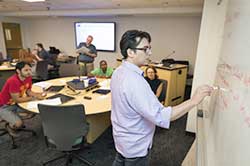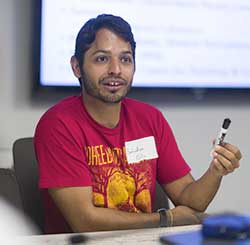Enhancing Diversity in Physics Teacher Preparation through the Georgia State University PhysTEC Project
Brian Thoms, Department of Physics and Astronomy, Georgia State University

Student Teacher Rick Farfan

Student Teacher Sebastian Ortiz

Teacher in Residence Elizabeth Walker
Introduction
As a PhysTEC (Physics Teacher Education Coalition) comprehensive site in the second year of a three year grant, the Georgia State University (GSU) team is working to further develop our model of physics teacher recruitment and development at a diverse, urban research university. One of our goals is to prepare and support more physics teachers from under-represented minority (URM) groups. In addition to creating a well-qualified physics teacher work force in the Atlanta area, this also creates role models and mentors for a diverse high school student population to inspire them toward pursuing careers in science and engineering (and maybe even physics teaching).
Recent efforts to build a thriving physics program with increased minority student success have established the foundation for producing more diverse physics teachers. Our PhysTEC project attempts to use a teacher-in-residence, learning assistants, and recruiting to bring more and more diverse students into physics teaching.
Physics at an Urban Research University
The setting of the university provides an excellent opportunity to increase the involvement of URM in physics and physics teaching. GSU is a growing urban research university whose 25,000 undergraduates form a vibrant and diverse community consisting of 37% White, 38% African American, 13% Asian, and 8% Hispanic students. GSU is diverse in other ways with half of all undergraduates being PELL eligible, over one third are first-generation college attendees, and one quarter are adult learners. Although there are no engineering programs at GSU, 18% of undergraduates are majoring in a STEM area.
Just having URM students at the university doesn’t bring them into the physics program or the teacher track. We followed successful efforts such as those described in the SPIN-UP report[1] to build a thriving BS program, doubling the number of physics majors in five years, and tripling the number of physics BS degrees in the last three years as seen in the tables below.

Also of note is that these increases in the physics program have produced a substantially larger impact on the number of minority students receiving Physics BS degrees. Although efforts to build the physics program were not aimed at minority students, removing the barriers proved to be more important for these students. Among these efforts were increasing the flexibility of the degree program requirements and making student class schedules more efficient. These program changes were important because many, if not most, of our students work outside of classes, and anecdotally we have seen that minority students often work more hours than our majority students. Further, a new concentration was developed for physics teacher education in which students are certified as high school physics teachers within their bachelor’s degree program.
Another significant change affecting minority participation in physics is the introduction of a freshman seminar. Our physics majors enter with a wide range of math preparation and most students take several math courses before they can begin the introductory calculus-based physics courses, meaning that they had little contact with the physics department or other physics majors in their first year. By introducing a class required for freshman physics majors, “Gateway to Physics,” aimed not at physics content but rather at physics as a career, students have the opportunity to develop their physics identity. This course has a much larger percentage of minority students compared with upper division physics courses, emblematic of the pipeline issues in physics. The Gateway course is an opportunity to present students with a realistic view of physics careers, including high school physics teaching, and provides the opportunity for students to see and meet a diverse group of physics majors.
The third significant action to build the program was the reinforcement of the physics club (Society of Physics Students). By giving them control of their room (even over furniture and paint) and support from faculty members, membership in SPS increased from less than 20 to over 50 students. This is another opportunity for students to find support as they make their way through the program which may be particularly important for first generation and minority students.
Increasing Diversity in the Physics Teacher Program
A key element involved in the recruiting and mentoring of future physics teachers for the PhysTEC program nationally is the Teacher in Residence (TIR). In the first year of our PhysTEC project we were fortunate to have Elizabeth Walker, an African-American woman with over 20 years of physics teaching experience, as our TIR. Through visits to the freshman Gateway class and other classes, Elizabeth was a living demonstration of the opportunities for successful careers in physics teaching for students from URM groups. She also mentored students through their internships in high school teaching and served as a resource for those considering teaching as a career.
Another element of the PhysTEC model is the use of undergraduate Learning Assistants (LAs). Our goal is to recruit top students to serve as LAs with special attention to including minority students. A diverse team of LAs serves as role models demonstrating physics teaching as a path open to everyone. Our course redesign will be complete in Spring 2015 with LAs leading tutorials in all sections of introductory calculus-based physics. It’s already clear that LAs have a tremendous effect on the recruitment of other LAs.
Our efforts to increase minority involvement in physics teaching are recent and there has been some success. The education concentration leading to physics certification was introduced in Fall 2012 and graduated its first students in December 2013. One of four students certified in 2013-2014 was an URM as are two of the five students performing internships in 2014-2015.
[1] The Strategic Programs for Innovations in Undergraduate Physics (SPIN-UP): Project Report is available at the APS website: http://www.aps.org/programs/education/undergrad/faculty/spinup/spinup-report.cfm.
Brian Thoms is an Associate Professor of Physics at Georgia State University where he has taught for 19 years. He also serves as Associate Chair and Undergraduate Director for the Department of Physics & Astronomy and as PI for the GSU PhysTEC Comprehensive Site Grant.
Disclaimer – The articles and opinion pieces found in this issue of the APS Forum on Education Newsletter are not peer refereed and represent solely the views of the authors and not necessarily the views of the APS.
